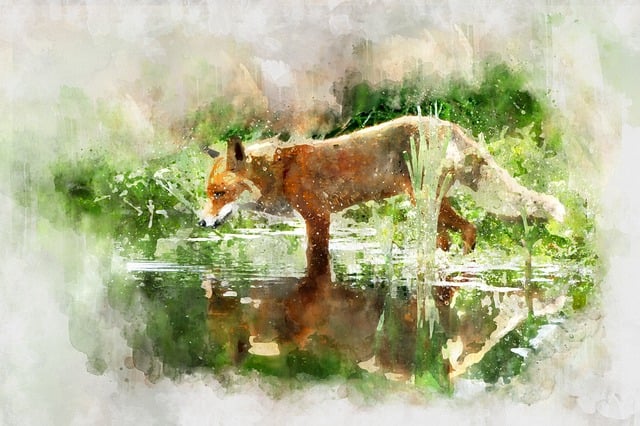Write On! Features: Foxes In Literature by Faye Anderson
By Faye Anderson, introduced by Madeleine F White
Madeleine says: “As a writer the idea of shapeshifting has always appealed to me. And I’m not the only one. From as early as Ovid’s Metamorphoses, the idea of one being changing into another to adapt, to flee, to conquer has been a core tenet of our creative culture.
Foxes, whether portrayed as tricksters in European folklore, or wise beings, such as Kitsune in the Far East, have been given human characteristics. So, when I found myself sharing a taxi with Faye on my way back home from the University of Kent, having been in a car crash earlier that morning, I jokingly said something like, I wish I could grow wings and fly back home to Broadstairs from Canterbury. Instead, Faye kindly offered me a lift back and we quickly started a discussion on how useful it would be to develop characteristics we see mirrored in nature, to help us through our day-to-day lives.
Faye, a Wildlife conservation student (who has now graduated) told me of her fascination for foxes. Ever on the look out for a good story, I asked Faye to tell us a little bit more about this wonderful creature that is now as at home in town and cities as it is in the countryside. Expressions such as ‘foxy,’ ‘out-foxing,’ and’ being foxed,’ will never seem the same again! And, who knows, Faye’s fox may well lead you into entirely new creative territories.”
*****
I am a lover of foxes and one of the things that has always saddened me is the way foxes are presented in media both past and present. When thinking of foxes, we quickly start thinking of how literature and television has made us view them. To set a bit of context, let’s explore some examples…
Where did people get the idea of the trickster fox? It all started with the earliest kind of storytelling, folk tales, where foxes are often presented as the tricksters; sly and cunning. Some Japanese folk tales focus on what is called Yokai. Yokai are spirits, usually seen as mischievous and mysterious spirits, manifesting in many forms. The Kitsune, for example, can be seen as large foxes, with nine tails. They are seen as tricksters, with shapeshifting abilities; turning into a human form. They are also often seen to have powers such as fire.
Reynard the fox is another foxy tale; this time coming to us from Europe in the middle ages. In this collection, the main character is a fox who is being hunted by the king, for stealing and other criminal deeds. In an attempt to arrest the fox, the king sends other animals to capture the creature. Each time, though, the fox is able to outwit them. The earliest version of this story was written in what is now modern-day Belgium, between 1148 – 1153.
Literature is littered with foxes – probably why there is a national fox day in September! A more modern depiction, and one of my personal favourites, is Fantastic Mr Fox, by Ronald Dahl. Mr Fox is shown sneaking into three farmers’ houses to kill poultry. When the farmers try to hunt him down, he outsmarts them by burrowing underground and into their houses to get to his prey. Once again, we have that same literary trope of foxes outsmarting the rest of us.
But what is the truth behind these gorgeous creatures, and how do we move past the misconceptions that have haunted our storytelling? As a passionate fan of foxes and a student of their behaviour, I thought it might be interesting to explore some of these misconceptions…
The idea of the fox being sly comes from their hunting technique: a sly hunter, who waits to pounce. They are also known for hunting solo, making them much more sneaky, so increasing the ability to sneak up on other animals, or, if needs be, to sneak away.
Farmers took this idea even further. Centuries ago, the main way farmers made a living was by breeding and producing livestock. As you can imagine, when foxes killed this livestock, it had a significant impact on the farmers.
You might also be interested to know foxes will eat anything and everything they come across. It’s this adaptability, as well as their intelligence, that, in my opinion, has given rise to the idea of them being cunning. This ‘cunning’ means the fox is smart enough to learn and change along with its ever-evolving habitat and so become a species thriving in environments ranging from the Arctic to woods, as well as cities and towns.
Another trait of the fox is that it is crepuscular. This means the species hunts mainly in the times of dusk and dawn, so most of their kills happen ‘unseen’. This includes their notoriety as killers of poultry. As we rarely venture out in the times they are abroad, foxes go unseen, leaving a trail of corpses in their wake (as they don’t always consume their pray after the kills).
In Europe, it’s the classic Red fox that claims our literary imagination. However, the Arctic fox is no less ‘cunning’ in terms of their hunting patterns. With a pure white coat which allows them to blend into their surroundings, their method of hunting is slightly different, due to their environment. Because their prey is often under the snow, they listen out for it, and when they hear a sound under the snow, they pounce, so catching their next meal.
To me, all the traits accredited with them being ‘cunning’ and ‘sly’ are actually what makes foxes so amazing. Another reason I love these adaptable canines is because of how they raise their young. They dig their own burrows, or take over burrows that have been abandoned by other animals, and the female and male raise their young together as a powerful family unit.
I want to end on a more serious note, though. I know to some the idea of the sly Mr Fox is just a literary given, but I believe these misconceptions can actually be harmful.
For example, it gives interfered permission for fox hunting, even though it was banned in 2004. It also makes it easier for us to think of foxes as pests when, in fact, they’re just adapting to us taking away their habitats; something that has lead to the Urban Fox becoming a scavenger, as they no longer have the woods to hunt within.
It’s my belief that we need to continue studying these wonderful creatures, so we can build a better understanding. There is a surprising lack of information on foxes available for the public on the internet, so if you’d like to find out more, do check out The Wildlife Trust websites. Also, to get more information on endangered species, I recommend looking on the ICUN (International Union For Conservation Of Nature) red list, which lists all endangered species, as well as information about them.
I call on you, as writers, to help change these misconceptions. Let’s put some positive foxy stories out there. Something children and adults can relate to, putting their intelligence and adaptability at the forefront, to create the stories of tomorrow.
*****
References used in this article:
https://www.thenakedscientists.com/articles/questions/are-foxes-really-cunning
https://mythus.fandom.com/wiki/Kitsune
https://www.woodlandtrust.org.uk/trees-woods-and-wildlife/animals/mammals/fox/
https://www.iucnredlist.org/
https://www.wildlifetrusts.org/
*****
Issue 18 of Write On! is out now and you can read it online here. Find it in libraries and other outlets. You can find previous editions of our magazines here and look out for issue 19, coming to you on 12 December!

You can hear great new ideas, creative work and writing tips on Write On! Audio. Find us on all major podcast platforms, including Apple and Google Podcasts and Spotify. Type Pen to Print into your browser and look for our logo, or find us on Podcasters.Spotify.com.
*****
If you or someone you know has been affected by issues covered in our pages, please see the relevant link below for information, advice and support: https://pentoprint.org/about/advice-support/
One thing that has always saddened me is the way foxes are presented in media both past and present.




